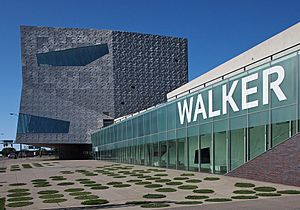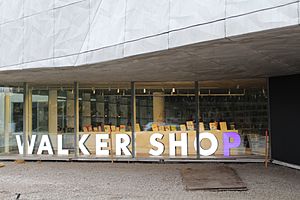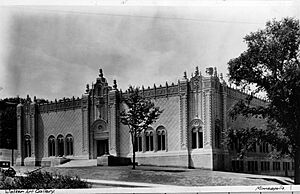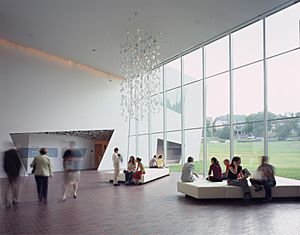Walker Art Center facts for kids
 |
|
 |
|
| Established | 1927 |
|---|---|
| Location | 725 Vineland Place Minneapolis, Minnesota, United States |
| Type | Art center |
The Walker Art Center is a cool place in Minneapolis, Minnesota, where you can see lots of contemporary art. It's one of the most popular modern art museums in the United States. Many people visit it each year, especially with the Minneapolis Sculpture Garden right next door!
The museum has a huge collection of over 13,000 pieces of modern and contemporary art. This includes paintings, sculptures, drawings, photos, and even costumes.
The Walker Art Center started way back in 1879. It began as an art gallery in the home of a man named Thomas Barlow Walker, who collected a lot of art. He officially opened his collection as the Walker Art Gallery in 1927. Later, in 1940, it became the Walker Art Center. The museum celebrated its 75th birthday as a public art center in 2015.
The main building you see today was designed by Edward Larrabee Barnes and opened in 1971. It got a big update and expansion in 2005. Swiss architects Herzog & de Meuron added more gallery space, a theater, a restaurant, and a shop.
Contents
What You Can See and Do at the Walker
Amazing Visual Art
The Walker Art Center has always focused on visual arts. They have many exhibitions that change regularly, plus a permanent collection of art they have bought or been given. Since the 1960s, the Walker has asked artists to create new works and even stay at the museum as artists-in-residence. Some famous artists who have worked with the Walker include Robert Irwin and Glenn Ligon.
The Walker's collection mainly shows modern and contemporary art, especially from after 1960. It has more than 13,000 items, like books, costumes, drawings, and paintings. In 2015, the Walker celebrated its 75th anniversary with a special exhibition called Art at the Center: 75 Years of Walker Collections.
Some cool artworks you might find there include:
- Chuck Close, Big Self-Portrait
- Franz Marc, Die grossen blauen Pferde (The Large Blue Horses)
- Edward Hopper, Office at Night
- Andy Warhol, 16 Jackies
Exciting Performing Arts
Live performances are a big part of what the Walker offers. They are known for showing many different kinds of performance art. In 1940, the Walker started hosting local dance shows, poetry readings, and concerts.
By 1963, this grew into the Center Opera, which focused on new musical works. This group later became the Minnesota Opera in 1970. That same year, the Walker officially made Performing Arts its own department.
Since the 1960s, the Walker has helped create 265 new performance works. Every year, they put on about 25 shows, including performance art, theater, dance, spoken word, and music. It's one of the biggest programs of its kind in a museum! Many artists have worked with the Walker for a long time, like choreographers Bill T. Jones, Meredith Monk, and Merce Cunningham. The Walker even got 150 art objects from the Merce Cunningham Dance Company in 2011, including sculptures, sets, and costumes by artists like Robert Rauschenberg.
Cool Movies and Videos
The Walker also has programs for film and video, showing both new and old works. In the 1940s, the Walker realized that movies and experimental films were important to modern life. Artists were exploring how film could use light, motion, and sound in new ways, different from regular movies.
In 1973, the Film/Video Department officially started. They also created the Edmond R. Ruben Film and Video Study Collection to save and study films as an art form. Today, this collection has over 850 titles. It includes classic and modern movies, documentaries, and experimental films by artists. You can find works by famous artists like Salvador Dalí and Marcel Duchamp, as well as modern artists like Nam June Paik.
Creative Design Work
The Walker has its own team of designers and editors. They create all the printed materials for the museum, like exhibition catalogs, magazines, and books. They also design graphics for exhibitions, signs, and advertisements.
This department also organizes design projects and programs, such as talks, exhibitions, and special art commissions. For over 60 years, they have put on important exhibitions about architecture and design. They also bring many architects, designers, and critics to the Twin Cities through programs like the Insights design lecture series. In the 1940s, the Walker even built two "idea houses" to show off the newest building materials and designs.
For more than 30 years, the Walker has offered the Mildred S. Friedman Design Fellowship, a year-long program for young designers.
Digital Media and Online Fun
The Walker's Digital Media group manages mnartists.org, an online place for artists and art groups in Minnesota. It's a digital meeting spot for the local art community. They also work with the Minneapolis Institute of Art to manage ArtsConnectEd, an online tool for art teachers that uses resources from both museums.
In 2011, the Walker's website was updated to be more like a news site. It features essays, interviews, and videos by staff and guest writers, plus news about art and culture from around the world. This new website was praised by many in the art world.
Learning and Community Programs
Learning is a key part of the Walker's mission. They offer many education programs, community events, and projects to help people understand art. The department has programs for families, schools, teens, and tours. They also run mnartists.org. All these programs cover visual art, performing arts, film/video, new media, design, and architecture. The staff works with curators, local organizations, artists, and schools to create these activities. Groups like the Walker Art Center Teen Arts Council help the museum connect with its audience.
Publishing Books and Magazines
The Walker has a long history of publishing. They create exhibition catalogs, books, and magazines, both in print and online. From 1946 to 1954, they published the Everyday Art Quarterly, which later became Design Quarterly. This magazine focused on how design affects society.
The Walker's design studio has created many exhibition catalogs for artists like Marcel Broodthaers, Andy Warhol, and Kara Walker. They also publish books on design, architecture, and other topics in contemporary art. In 2011, the Walker's website became an "idea hub," a news-magazine style site with original interviews, videos, and essays. This publishing-focused homepage was called a "game-changer" and a "model for other institutions." It won several awards in 2012. In 2017, the website was redesigned again, and its digital publishing was named Walker Reader.
In April 2020, The New York Times said the Walker website was one of the best museum sites during the time when many places were closed. They noted that "Walker Reader" was an important part of the museum's online presence. The Walker Reader stopped publishing in August 2020.
The Walker's Campus

The Walker Art Center is located on a 17-acre campus. Its main building is 8 stories tall and has 10 art galleries, a cinema, a theater, a shop, a restaurant, and a café. It also has spaces for special events and lectures.
The original building, designed by Edward Larrabee Barnes, opened in May 1971. Barnes designed it in a simple, modern style with brick on the outside and large white spaces inside. The galleries spiral up around a central staircase, leading to rooftop terraces. The building's design was highly praised when it opened.
In 2005, the building had a big expansion designed by Swiss architects Jacques Herzog and Pierre de Meuron. This addition was meant to make the building more open and welcoming, like a "town square." Its main feature is a tall, abstract tower made of aluminum mesh and glass. This tower holds the theater, restaurant, and shop. Windowed halls connect the tower to the original building, adding more gallery space.
In 2015, the Walker announced plans to connect the museum more closely with the Minneapolis Sculpture Garden. This renovation included a new entrance for the Walker, a new green space called the Upper Garden, and rebuilding the 26-year-old sculpture garden. The project also added green-roof technology and systems to collect rainwater. The renovation was finished in November 2016, and the sculpture garden reopened in spring 2017.
History of the Walker Art Center
The Walker Art Center began with Thomas Barlow Walker, a businessman from Minneapolis who had one of the largest art collections in the country. In 1879, he opened part of his home to the public for free to see his art. In 1916, Walker bought land to build a museum for his growing collection. His museum, the Walker Art Galleries, opened on May 21, 1927.
In 1939, the Minnesota Arts Council took over the building and its art collection to create a public art center. With help from the Works Progress Administration, improvements were made, and the Walker Art Center opened in January 1940. Around this time, the Walker officially started focusing on modern and contemporary artworks.
The Walker's current building, designed by Edward Larrabee Barnes, opened in 1971. The Minneapolis Sculpture Garden was added to the Walker's campus in 1988, in partnership with Minneapolis Parks and Recreation.
In 1984, the Walker Art Center hosted artist Keith Haring, who created many famous works and murals there.
The most recent building expansion, designed by Herzog & de Meuron, opened in April 2005. It almost doubled the size of the Walker Art Center, adding more gallery space, a theater, a restaurant, a shop, and special event areas.
In June 2017, the reopening of the Minneapolis Sculpture Garden was delayed because of discussions about Sam Durant's sculpture Scaffold.
Important Dates in Walker History
- 1879 – Thomas Barlow Walker opens the first public art gallery west of the Mississippi River in his home.
- 1927 – Walker Art Galleries opens in Minneapolis.
- 1940 – With funding from the Works Projects Administration, Walker Art Galleries becomes the Walker Art Center. It starts focusing on modern and regional art. The first performance event, the Spring Dance Festival, takes place.
- 1942 – Franz Marc's Die grossen blauen Pferde (The Large Blue Horses) (1911) is the first modern art piece bought by the Walker.
- 1946 – The Everyday Art Gallery opens, the first exhibition space in a U.S. museum just for design. The Everyday Art Quarterly (later Design Quarterly) magazine begins.
- 1948 – Edward Hopper's Office at Night (1940) is acquired.
- 1963 – The Walker Art Center creates the Center Opera Company, which later becomes the Minnesota Opera. John Cage and the Merce Cunningham Dance Company perform at the Walker for the first time.
- 1967 – Andy Warhol's 16 Jackies (1964) is acquired.
- 1969 – Major artworks like Chuck Close's Big Self-Portrait (1967–1968) are acquired.
- 1970 – The Performing Arts Department is officially formed.
- 1971 – The new Walker Art Center building, designed by Edward Larrabee Barnes, opens.
- 1972 – The Film/Video Department is created.
- 1976 – The Walker becomes a public institution.
- 1988 – The Minneapolis Sculpture Garden opens, designed by Edward Larrabee Barnes. It includes Spoonbridge and Cherry by Claes Oldenburg and Coosje van Bruggen.
- 1996 – The New Media Initiatives Department is formed, and Gallery 9, a website for net art, launches.
- 1998 – Charles Ray's Unpainted Sculpture (1997) is acquired. ArtsConnectEd, a website with collections from the Walker and the Minneapolis Institute of Art, launches.
- 2002 – mnartists.org, a project by the Walker and the McKnight Foundation, launches.
- 2005 – The newly expanded Walker Art Center, designed by Herzog & de Meuron, opens in April.
- 2012 – Walker Art Center hosts the first Internet Cat Video Festival.
- 2015 – The Walker begins renovating the Minneapolis Sculpture Garden.
- 2024 – A group of union workers at the gallery use social media to discuss the art gallery's no-sitting policy.
Who Runs the Walker Art Center
How the Walker Gets Money
The Walker Art Center gets some money from the Minnesota State Arts Board. To keep its creative freedom, the director at the time, Kathy Halbreich, decided not to take millions of dollars in state help for the museum's big expansion in 2005. This meant some staff changes and a temporary freeze on salaries.
In 2011, the Walker Art Center had assets worth $243 million. Its yearly costs were about $22 million, and its special fund (endowment) was $152 million.
Who Visits the Walker
In 2011, about 590,000 people visited the Walker. About 22% of these visitors were teens and young people!
Leaders of the Walker
- Daniel Defenbacher, 1940–1951
- Harvey Arneson, 1951–1961
- Martin Friedman, 1961–1990
- Kathy Halbreich, 1991–2007
- Olga Viso, 2007–2017
- Mary Ceruti, 2019–present
More to Explore
- Minneapolis Sculpture Garden
- MNartists.org
See also
 In Spanish: Centro de Arte Walker para niños
In Spanish: Centro de Arte Walker para niños



